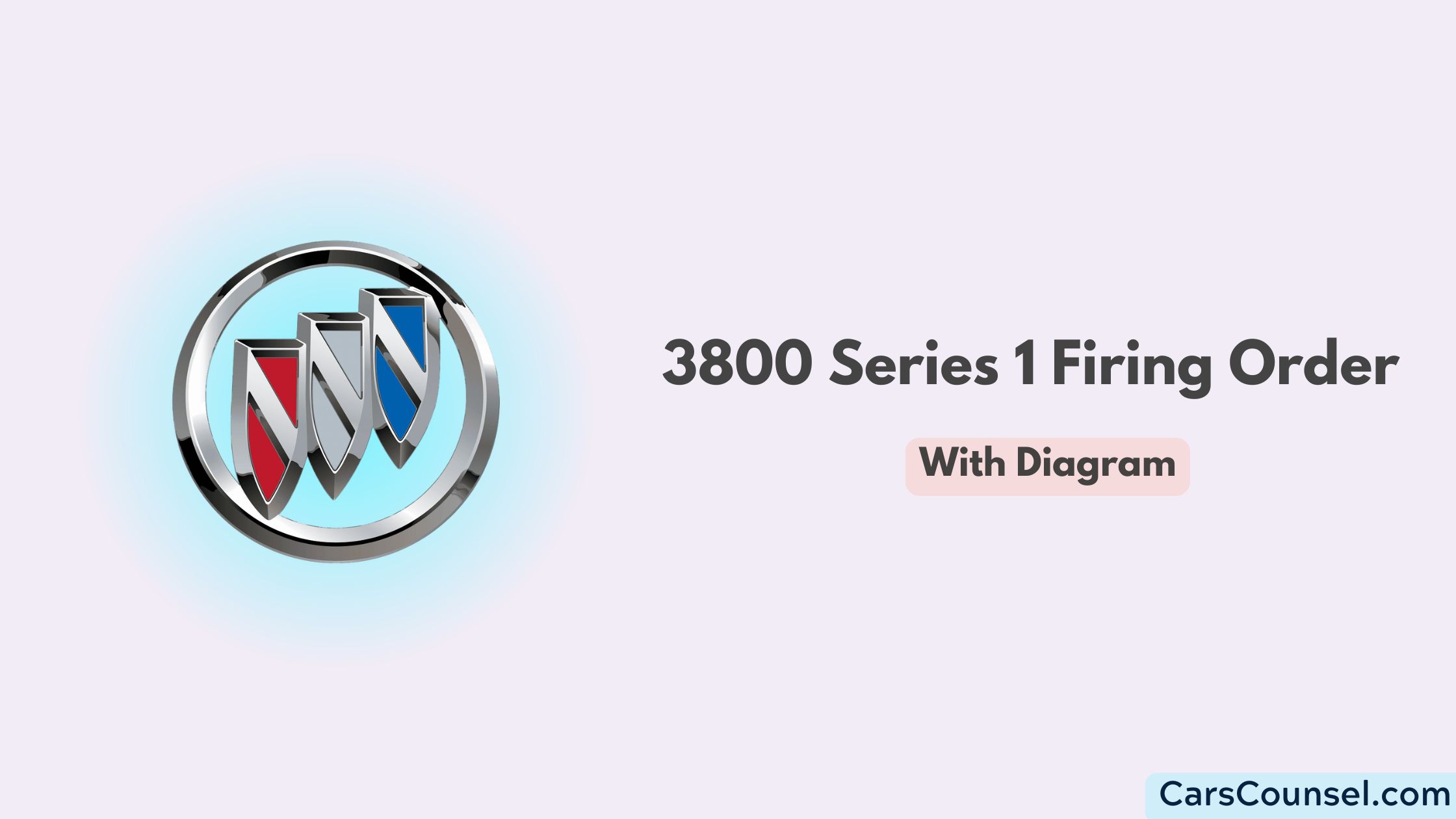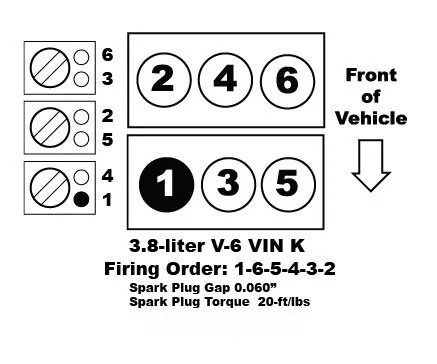The 3800 Series 1 engine, also known as the Buick 3.8L V6, is one of the most reliable and long-lasting engines produced by General Motors (GM). Found in various GM vehicles during the 1980s and early 1990s, this engine is celebrated for its balance of performance and durability.
A critical component of the engine’s operation is its firing order, which ensures the cylinders fire in the correct sequence for optimal performance.
In this guide, we’ll break down the firing order for the 3800 Series 1 engine, explain its importance, and provide insights into troubleshooting and maintenance. Whether you’re working on an older GM car or just curious about this engine’s mechanics, this article will keep things simple and focused.

Quick Navigation
The 3800 Series 1 Firing Order
The firing order for the 3800 Series 1 engine is: 1-6-5-4-3-2

How the Firing Order Works
- Cylinder 1 Fires First: The frontmost cylinder on Bank 1 starts the ignition cycle.
- Cylinder 6 Fires Next: The rearmost cylinder on Bank 2 follows.
- Cylinder 5 Fires Third: Ignition returns to Bank 1, firing the rearmost cylinder.
- Cylinder 4 Fires Fourth: The second cylinder on Bank 2 fires next.
- Cylinder 3 Fires Fifth: Ignition moves back to Bank 1, firing the middle cylinder.
- Cylinder 2 Fires Last: The sequence ends with the second cylinder on Bank 2 before restarting.
This firing order alternates ignition between banks, providing balanced power delivery and reducing engine vibrations.
Why GM Chose the 1-6-5-4-3-2 Firing Order
The 1-6-5-4-3-2 firing order was selected for the 3800 Series 1 engine for several reasons:
- Balance: Alternating between the two banks helps balance the forces acting on the crankshaft, reducing stress and wear.
- Smooth Power Delivery: Continuous combustion prevents interruptions, ensuring smooth acceleration.
- Efficiency: This sequence promotes optimal airflow and combustion, maximizing fuel efficiency.
- Durability: Balanced operation extends the lifespan of engine components by reducing strain.
What Is a Firing Order?
The firing order is the sequence in which an engine’s spark plugs ignite the air-fuel mixture inside the cylinders. This sequence ensures the engine runs smoothly by balancing power delivery and minimizing vibrations.
Why Is the Firing Order Important?
- Smooth Operation: Ensures that combustion events are evenly distributed, reducing vibrations.
- Performance: A proper firing order delivers consistent power output for smooth acceleration.
- Fuel Efficiency: Correct sequencing ensures complete combustion, optimizing fuel use.
- Durability: A balanced firing sequence prevents undue stress on the crankshaft and other engine components.
3800 Series 1 Engine Overview
The 3800 Series 1 engine is a 3.8L V6, featuring a 90-degree V-shaped cylinder layout. This configuration allows for a compact yet powerful engine design suitable for various applications, including sedans and coupes.
Engine Configuration
- V6 Layout: Six cylinders arranged in two banks of three, forming a “V” shape.
- Overhead Valve (OHV) Design: Utilizes pushrods to operate the intake and exhaust valves.
- Cylinder Numbering:
- Bank 1: Cylinders 1, 3, and 5 (front bank, closest to the radiator).
- Bank 2: Cylinders 2, 4, and 6 (rear bank, closest to the firewall).
Identifying the Firing Order
Knowing how to identify the firing order is essential for maintenance and troubleshooting. Here’s how to verify the firing order in the 3800 Series 1 engine:
Consult the Owner’s Manual
The owner’s manual provides engine specifications, including the firing order and cylinder layout.
Cylinder Markings
Cylinder numbers are often stamped on the intake manifold or near the spark plugs, helping identify their positions.
Use a Repair Manual
Professional service manuals include diagrams and detailed instructions for understanding the firing order and ignition system.
Symptoms of Incorrect Firing Order
An incorrect firing order can cause a range of performance issues. If the spark plugs are firing out of sequence, you may experience these symptoms:
Common Symptoms
- Engine Misfires: Cylinders fail to fire correctly, causing uneven power delivery.
- Rough Idling: The engine vibrates excessively or feels unstable when idle.
- Power Loss: The car struggles to accelerate or maintain speed.
- Unusual Noises: Knocking, pinging, or backfiring sounds may occur.
- Increased Fuel Consumption: Inefficient combustion leads to higher fuel use and emissions.
Causes of Incorrect Firing Order
- Misconnected Spark Plug Wires: Spark plug wires connected to the wrong cylinders disrupt the firing sequence.
- Faulty Ignition Components: Worn spark plugs, ignition coils, or distributors can affect timing.
- Timing Chain Issues: A misaligned timing chain or gear can throw off synchronization.
Diagnosing and Fixing Firing Order Problems
If you suspect firing order issues in your 3800 Series 1 engine, follow these steps to diagnose and resolve the problem:
Diagnostic Steps
- Inspect Spark Plug Connections: Verify that each spark plug wire is routed to the correct cylinder based on the 1-6-5-4-3-2 firing order.
- Check Ignition Components: Examine spark plugs, ignition coils, and the distributor for wear or damage.
- Verify Timing Alignment: Use a timing light to confirm that the timing chain or gear is properly aligned.
- Scan for Error Codes: Use an OBD-I scanner to identify any ignition-related error codes.
Fixing Common Issues
- Reconnect Spark Plug Wires: Ensure the wires follow the correct firing order.
- Replace Faulty Components: Install new spark plugs, ignition coils, or distributors as needed.
- Adjust Timing: If the timing chain or gear is misaligned, realign it to factory specifications.
Preventative Maintenance for Firing Order Reliability
Maintaining the correct firing order is crucial for the long-term performance of your 3800 Series 1 engine. Follow these tips to prevent firing order issues:
Regular Inspections
- Check spark plugs, ignition wires, and the distributor cap during routine maintenance.
- Look for loose connections, corrosion, or visible damage.
Replace Components as Needed
- Replace spark plugs and ignition wires at intervals recommended by GM.
- Use high-quality OEM parts for compatibility and reliability.
Timing Chain Maintenance
- Inspect the timing chain for wear or slack, especially in high-mileage engines.
- Follow GM’s maintenance schedule for timing chain inspections and replacements.
FAQs About the 3800 Series 1 Firing Order
Can I Change the Firing Order?
No, the firing order is fixed based on the engine design and crankshaft configuration. Changing it would require extensive engine modifications.
What Happens If the Firing Order Is Incorrect?
An incorrect firing order can cause misfires, rough idling, power loss, and potential damage to engine components.
How Can I Verify the Firing Order?
Refer to the owner’s manual or a service manual. Cylinder markings and diagnostic tools can also help confirm proper ignition timing.
Is the Firing Order the Same for All V6 Engines?
No, while many V6 engines use similar firing orders, specific configurations can vary depending on the manufacturer and engine design.
Engines with Similar Firing Orders
- Buick 455 Firing Order
- 2008 Buick Lacrosse Firing Order
- 2012 Buick Enclave Firing Order
- 2009 Buick Enclave Firing Order
- 3800 Series 2 Firing Order
Conclusion
The 1-6-5-4-3-2 firing order is a fundamental aspect of the 3800 Series 1 engine’s operation. This sequence ensures smooth performance, balanced power delivery, and efficient combustion. By understanding the firing order and maintaining the ignition system, you can keep your engine running reliably for years to come.
Whether you’re troubleshooting engine issues or performing routine maintenance, knowing the firing order is essential for working with the 3800 Series 1 engine. With proper care and attention, this iconic GM engine will continue to deliver dependable performance and durability.

